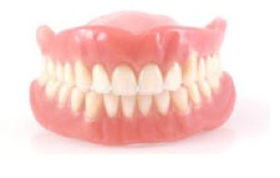Fixed and Removable Prosthetics
Fixed Prosthetics
Fixed prosthetics simply means any restorative dentistry that is placed in our patient’s mouths remains there permanently. It is NOT removable. Two visits are usually required these types of procedures.
Inlays and onlays may be considered as a “partial” crown. This is a more conservative approach to save tooth structure but still provide a permanent restoration that will usually last longer than a plastic composite filling. These can be made out of tooth colored materials or gold. Both are suitable for long term protection; however, the gold might last a bit longer due to their metal properties.
Crowns or “caps” are designed to cover the entire tooth. Think of it as a thin “shell” that is placed over the tooth. Usually when more than 60 – 70% of the natural tooth is missing due to dental decay or tooth fractures, a full coverage crown is placed. Once again these are permanent restorations that are NOT removable.
Removable Prosthetics
 When choosing a removable prosthetic appliance or “partial” to replace missing teeth, there are several things to consider:
When choosing a removable prosthetic appliance or “partial” to replace missing teeth, there are several things to consider:
- Comfort – the appliance must be comfortable above all or else the patient will not wear it. It doesn’t matter how well if fits, if it’s not comfortable it ends up in the drawer in their night stand next to the bed.The advantage of metal partials is that they provide more stability and less material is usually needed to fabricate these appliances. Small rest seats are placed in the teeth to offer tooth support along with the gum tissue to provide a much better fit.If you’re considering plastic partials, I have found better success with upper plastic partials than lower ones because there’s more surface area to cover in the roof of your mouth and the plastic will not have a tendency to dig into the gum tissue as much. In the lower arch it’s a little more difficult wear. The tongue and cheeks are usually competing for space with the appliance. Less surface area also means more pressure is placed on the gums. Plastic partials usually require more material to fabricate these and may create a sense of “fullness” in your mouth.
- Stability – metal partials will normally fit better than the plastic partials. The more rigid the appliance, the less movement you’ll feel when chewing or masticating your food. There will be less chance for soar spots developing if the partial is not wiggling or rocking in the mouth.
- Materials – whether it’s a plastic or metal based partial, compatibility testing suggest to only use Vitalon, Vitalon Clear, Valplast or Titanium. We’ve had excellent results with these materials. We do NOT use any nickel, palladium or cadmium products in the fabrication of our appliances.
- Longevity – obviously metal partials seem to last much longer than plastic ones. Plastic partials can break easier than the metal appliances when exposed to occlusal forces that exceed the limits of plastics.
- Cost – plastic partials will cost less than the metal ones. When choosing your removable appliance, cost is certainly an important factor but remember to consider all the options that were listed above as you make your final decision.

